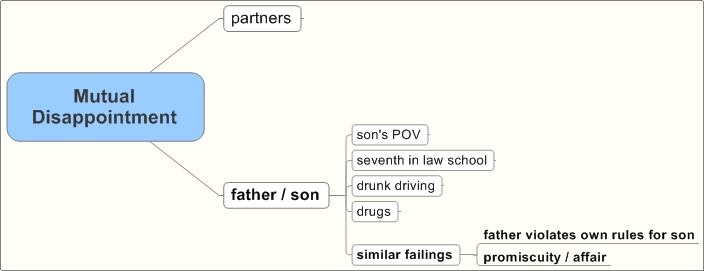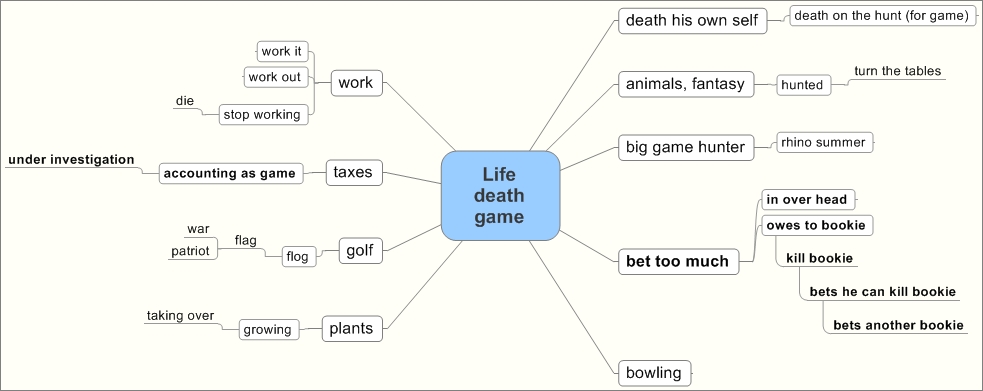Developing Story Ideas by Clustering
In early April, eleven of my local writer friends and I held a weekend writer’s retreat at a dome house in the Sierra Nevada foothills.
One of my goals for the retreat was to practice developing ideas into story ideas, and then into stories. And I had a technique in mind that I wanted to practice: clustering.
I’d learned about clustering years ago from a writing teacher in New Hampshire, who had learned it from Gabriele Rico’s book Writing the Natural Way. Dustin Wax describes the technique nicely on his blog, and you can see a Flash animation of clustering in action at the top of Rico’s web site.
I’d used clustering dozens of times for my non-fiction writing (and also for general problem-solving), so I knew it was a great technique for tapping the creative, associative workings of your mind. But I hadn’t yet used clustering to develop story ideas for fiction, and this was a great opportunity.
So that’s how I would develop ideas into story ideas. Where would I find the raw, undeveloped ideas to cluster about? From my brand new copy of The Writer’s Book of Matches, a small book filled with hundreds of intriguing writing prompts.
So I had plan:
- Pick a random prompt from The Writer's Book of Matches.
- Cluster around the core idea of the prompt until a story idea hit me.
- Write down the story idea.
- Write the story.
My first prompt was:
“He’s probably just as disappointed in me as I am in him.”
The core of this idea is mutual disappointment. But who are the people involved, and what are they disappointed about? This is a great job for clustering. I grabbed my pen and an 8"x5" index card and drew this cluster (rendered here using MindJet’s MindManager software):

As I dumped associations onto the card, I quickly found a story idea (in the branches I’ve bolded on the map):
A father has long expressed disappointment in his son’s sexual promiscuity. Then the son catches the father having an affair.
This story idea had some real juice for me, especially if I wrote it from the son’s point of view. I didn’t want to cluster any more, I wanted to write. I dashed off a 1,000-word first draft of a story called “Dinner at Gourlay’s”.
The next prompt that I pulled out of The Writer’s Book of Matches was:
“It’s supposed to be a game, but he treats it like life and death.”
The key words seemed to be life, death, and game, so I put those words in the center of an index card and created this cluster:

This time the story didn’t jump out at me instantly. It took a whole five minutes to find an idea that interested me. The “bet too much” bubble caught my attention because it connected game with death. Digging yourself too deeply into debt with your bookie (so the stereotype goes) can put you at serious bodily risk. So imagine a guy deeply in debt and being threatened by his bookie. What might the guy do? Maybe he’d kill the bookie, or try to. Then I thought of a twist: What if the guy bets a second bookie that he can kill the one to whom he’s in debt? After a few more twists, I had enough of an idea to start writing:
Norm is deeply in debt to his bookie Paulo. He tries to hire Emile, a competing bookie, to kill Paulo. But Emile doesn’t like the idea. Instead, he offers a deal: If Norm can kill the Paulo in a week, Emile will pay off the debt. If Norm can’t kill Paulo in a week, Emile will still pay off the debt, but then Norm will owe Emile twice the amount he owed Paulo. Double or nothing.
That prompt led to this story idea? Cool!
I wrote the first scene, which I quite like. But at the moment I don’t know where the story goes next. I like the idea that the Emile tips off Paulo that Norm is coming to kill him, but so far I can’t figure out Emile’s motivation to do that. But it would be fun, so I’ll keep looking.
Time for more clustering.